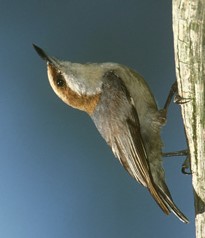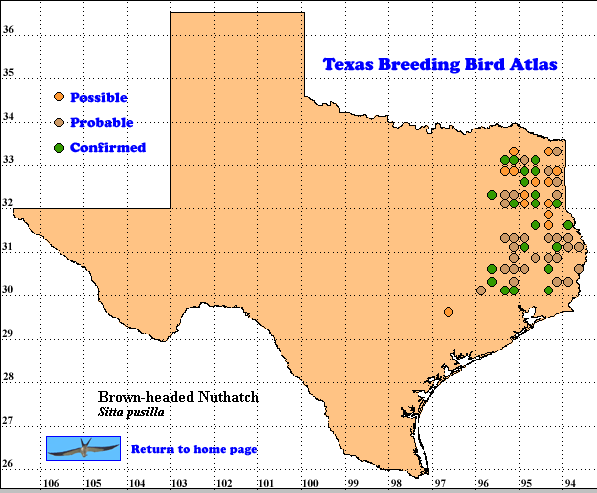While Texas currently has the distinction of having all four North American nuthatch species on its state list, the status of all 4 species in this state is not secure. Climate changes can affect the higher elevation habitats in the Trans-Pecos mountains where breeding has been detected for 3 species, while pressures from timber harvesting and development threaten two species in east Texas.
Brown-heads, like other nuthatches, forage for small insects and spiders in bark crevices on mature pine trees during the breeding season and use bark chips as tools to pry up loose bark during their foraging. In winter they switch to pine seeds (Withgott and Smith 1998). ).
DISTRIBUTION. During the 1987-1992 field work seasons of the TBBA project, atlasers found confirmed breeding evidence for Brown- headed Nuthatch in the Pineywoods and adjoining portions of the Post Oak Savannah regions in east Texas (see the region map in Lockwood and Freeman [2004]). A map produced from North American Breeding Bird Survey (BBS) data is similar to the TBBA map and shows a relative abundance as high as 1-3 individuals per route per year along the Louisiana border. From Texas the range of this nuthatch extends north and east through Oklahoma, southern Arkansas and the Gulf and Atlantic coast states to Maryland and Delaware (Sauer 2005).
SEASONAL OCCURRENCE. Brown- headed Nuthatch is a resident in east Texas where it breeds from mid-February to late May, based on egg dates from March 21 to April 19 and young in the nest as late as May 11 (Oberholser 1974). TBBA data suggest a longer breeding season based on recently fledged young seen from March 1 to July 26.
REEDING HABITAT. Brown-headed Nuthatches breed in Texas from near sea level to about 90 m (300 ft) in open pine forests (Oberholser 1974) with mature trees and standing snags. These nut.hatches usually excavates a cavity in dead or decaying wood, but may also use an existing cavity or a nest box. The cavity may be as low as 0.2 m (8 in) above ground. Cavity and entrance dimensions are quite variable, probably depending on the softness of the wood. Entrance holes may be as small as 2.5 cm (1 in) and cavities may average as deep as 17.8 cm (7 in). Nests are lined with materials such as pine seed husks, cotton, cocoon fragments, wood chips, feathers and bark strips (Withgott and Smith 1998).
The female usually lays about 5 (range 3-7) white to buffy eggs with profuse reddish brown markings; she incubates for 14 days. The young birds leave the nest 18-19 days after hatching and remain dependent on their parents for 2-4 weeks after leaving the nest. Pairs normally raise one brood per season and may be assisted by young males in nest building and sanitation and feeding of young (Harrison 1979, Withgott and Smith 1998, Cox and Slater 2007). ).
STATUS. Brown-headed Nuthatches are locally common to rare residents in eastern Texas (Lockwood and Freeman 2004). TBBA field workers found 24 confirmed, 30 probable and 20 possible breeding records, while in Oklahoma atlasers found only one probable record (in the extreme southeast) for this species, now rated as rare and local there (Duggan and Carter 2004).
BBS data for the period 1980-2005 from 14 routes in Texas on which Brown-headed Nuthatches were detected produces a trend of -3.8%. Although this estimate is not statistically significant, it is similar to the trend for Louisiana, derived from 29 routes of -5.1% which is significant at the 99% level (Sauer et al. 2005). . Since Texas is at the southwest corner of the range of this species, careful preservation of old-growth pine forests will be necessary to preserve this species as a member of the Texas avifauna.
Text by Robert C. Tweit (2007)
Literature cited.
Cox, J. A. and G. L. Slater. 2007. Cooperative breeding in the Brown-headed Nuthatch. Wilson J. Ornithol. 119: 1-8.
Duggan, M. D. and W. A. Carter. 2004. Brown-headed Nuthatch (Sitta pusilla). In Oklahoma breeding bird atlas, pp. 310-311 (D. L. Reinking, ed.). University of Oklahoma Press, Norman.
Harrison, H. H. 1979. A field guide to western birds’ nests. Houghton Mifflin, Boston, MA.
Lockwood, M. W. and B. Freeman. 2004. The TOS handbook of Texas birds. Texas A&M University Press, College Station.
Oberholser, H. C. 1974. The bird life of Texas. University of Texas Press, Austin.
Sauer, J. R., J. E. Hines, and J. Fallon. 2005. The North American Breeding Bird Survey, results and analysis 1966-2005. Version 6.2 2006. USGS Patuxent Wildlife Research Center, Laurel MD < http://www.mbr-pwrc.usgs.gov/bbs>
Withgott, J. H. and K. G. Smith. 1998. Brown-headed Nuthatch (Sitta pusilla). In The birds of North America, No. 349 (A. Poole and F. Gill, eds.). The Birds of North America, Inc., Philadelphia, PA.

